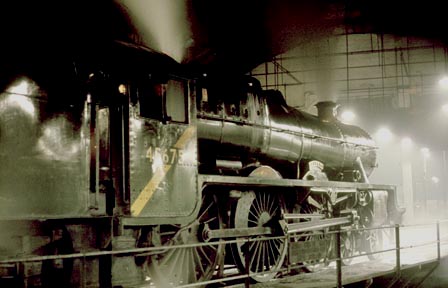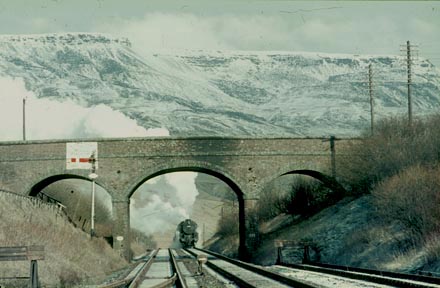Ex LMSR Jubilee class 4-6-0 number 45605 'Cyprus' departs Gloucester Eastgate station over Barton Street crossing with a Bristol bound express

I had a vision of 'P. Riley'. I'd met R. C. Riley, a charming man who wore a suit and worked in the City. P. Riley's pictures, on the whole, were not very different from those of his namesake. So, should I ever chance to meet him, I expected an urbane, middle-aged man of impeccable style and manners.
Leeds City Station, August 1967.1 was on my way to Holbeck with a friend when we happened to wander into a seedy little cafe in Jack Lane. And there, huddled under a dingy 40-watt light, mouth full of over-cooked baked beans and bacon with the rind still on, sat the object of my adulation. I suddenly realised that I knew him. We'd met and exchanged pleasantries the year before. Blue Peter had been heading for Aberdeen from Edinburgh the last time it would work a real train between those cities. It was a Saturday in late August. My car load had positioned themselves on Dalgety bank, just east of Inverkeithing. The train was due in three minutes. Suddenly, a car screeched to a halt, four bodies hurtled down the embankment and up trees and telegraph poles. It was only then that they realised we were blocking their shots. Amidst the torrent of abuse that rang round the cutting, I gathered they'd cleaned the engine. It arrived in mid-torrent; the driver's response to their efforts was to open the cylinder cocks and render the shot almost useless. The Midland Neverers Association had unwittingly arrived in my life.
Nine months later, the self-same picture landed on my doorstep. Mike Higson, then owner of the late-lamented Roundhouse bookshop in Harrow, had asked me to help him try and compile a definitive Steam in Scotland photographic album. W. J. V Anderson had finally been persuaded, Derek Cross was no problem. But there was no decent coverage of the Waverley Route. So I wrote to P. Riley. Back came a courteous letter and some 15 in x 12 in prints of such dire quality that we couldn't use them, including No. 60532 at Dalgety. Fast forward to Jack Lane, Leeds.
Six in the morning had rendered Paul fairly harmless, so we got chatting. He didn't do his own printing. As far as he was concerned, the taking of the picture was almost more important than the end result. It was an attitude that was to change quite rapidly, as did his approach to photography. The entourage sitting around him in the cafe's squalor were all names that I recognised from the railway press - C. E. Weston, D. Gouldthorp, M. York, P. Claxton. They were fairly uncommunicative; some still are. But they obviously looked up to Paul as the unspoken leader of their ad hoc group. By the end of breakfast, he and I had agreed to disagree on our views of photography, but became friends until his death.

Ex LMSR Jubilee class 4-6-0 number 45675 'Hardy' stands on a roundhouse turntable at York shed in December 1966
The 'photographic' elite of the post-war years were, by and large, fairly well- off users of large format or 6x6 cameras. There were exceptions R. E Vincent and C. C. B. Herbert were both avid enthusiasts for 35mm. But we're talking Leicas here, not Halina 35xs or the like. Paul Riley was young, fairly impoverished, and wanted to emulate W. J. V Anderson. So, instead of a Zeiss Ikonta or the vastly more expensive Linhof Technica that both Anderson and Cross were using, he settled for a humble Pentax 35mm. His early work around the Midlands and places like Stoke Bank on the East Coast main line is still interesting rather than exceptional - good quality, straight-down-the-middle, front three-quarter views of main line steam. His published work in 1963-4 was very much in the mould of Bill Anderson - dramatic, low-angle, slightly condensed in perspective. Anderson always used a slightly longer than normal focal-length lens on his plate cameras, and, in about 1965, Paul Riley discovered the telephoto lens. It was a discovery that was to change the face of conventional railway photography.
Whether Paul Riley 'invented' the use of the telephoto lens or not is debatable; what is certain is that he produced some of the greatest and most powerful images ever to leave the back of a camera. Perhaps it was something to do with his character, but the images he produced were about the masculinity of the steam engine - forget any thoughts about calling a 'Duchess' a 'she'; Riley's pictures, like his lifestyle, left little to the imagination. That is not a criticism. The vast majority of well-published railway photographers have seen their work in print thanks to the quality of their camera lenses rather than the quality of their perception. Paul Riley was different.
In the days before motor-drives, he would happily run off three rolls of Agfa CT18 before breakfast. Invariably, this scatter-gun approach paid off: he had a love of the landscape that could make virtually every frame a 'master shot' - witness his coverage of No. 70013 working the last passenger train up Shap on Boxing Day, 1967, the superb sequence of No. 48448 battling up to Copy Pit early in 1968, or his footage on Shap in December 1967 of backlit freights taken on a 400 mm lens which cost a fraction of a filter for a Linhof They are the work of a master. Sadly, though, a vast quantity of Paul Riley's work has bypassed an entire generation.

Ex LMSR Jubilee class 4-6-0 number 45562 'Alberta' picks up water from Dillicar troughs prior to tackling the climb to Shap summit unaided with the Border Countryman railtour on 25th February 1967
What is arguably one of the most exciting photographic collections in the British Isles
remains shrouded in secrecy. The MNA, an acronym for the Midland Neverers Association,
was an organisation founded on a common desire to travel by train while avoiding paying
for the privilege. Its members also cleaned engines in their spare time. Paul Riley was
the unspoken and unopposed leader. There was a feeling of almost Masonic brotherhood
about the organisation when it flourished in the mid-1960s. Sadly, not a lot has changed
and Paul Riley's contribution to the development of black and white photography remains
locked up in somebody's misguided vision of keeping the old memories pure. Riley's
remarkable vision deserves a better epitaph.
So enjoy what you see here, and search back into the 1960s world of Trains Illustrated
and Modern Railways. If you want to read about Paul in his own words, hunt for back
copies of Steam Railway for June and July 1992. His eloquent descriptions of travels by
bike, RDU 290, and 'Britannias' is as good a way as any into the mind of somebody who
could climb up the outside of the Castle Keep in Newcastle in order to get the master
shot without paying, could climb an electricity pylon to see off a 'Q6', or dive off
Cleethorpes Pier while the tide was out, thereby breaking both wrists and rendering
himself unemployable as a roadie for a folk band.

Ex LMSR class 5MT 4-6-0 number 44912 approaches Ais Gill summit with a southbound freight in April 1967

